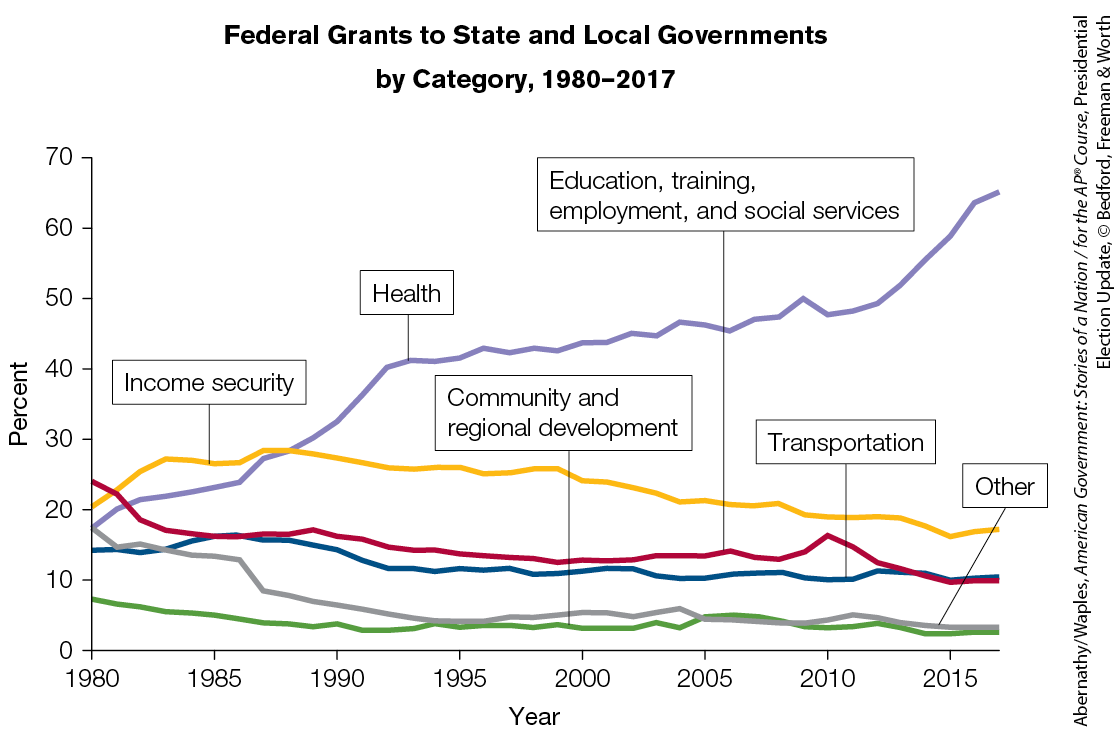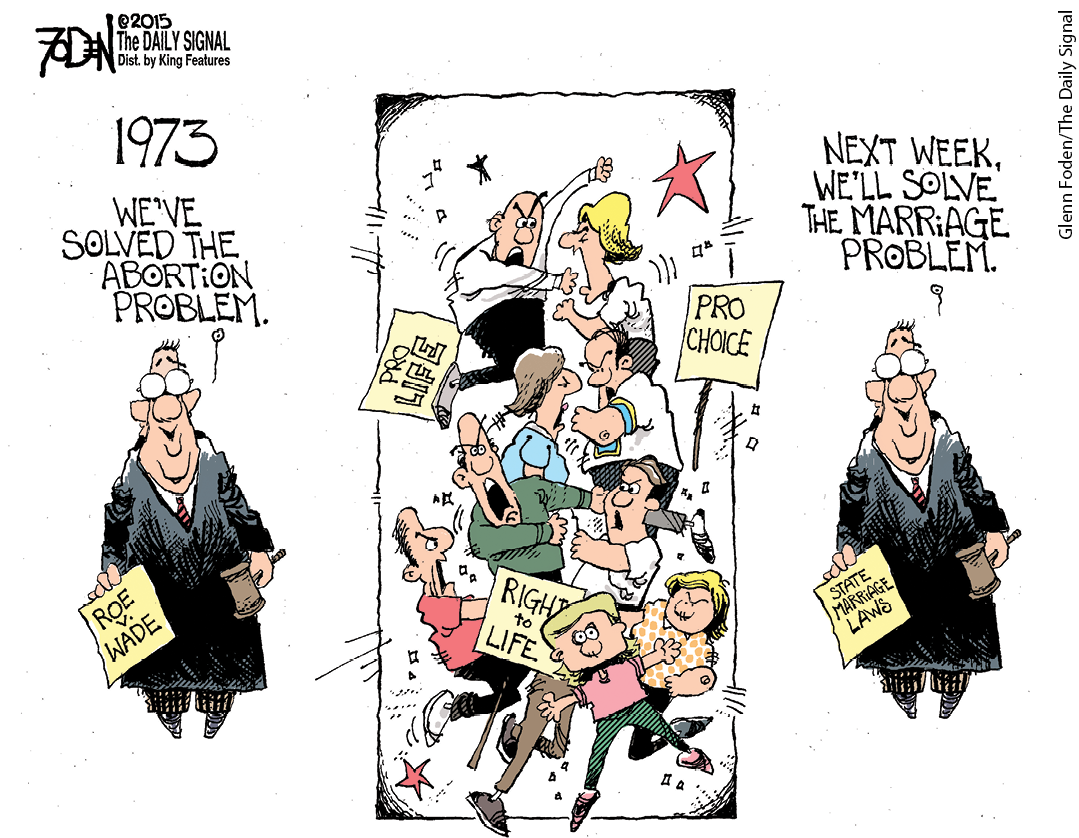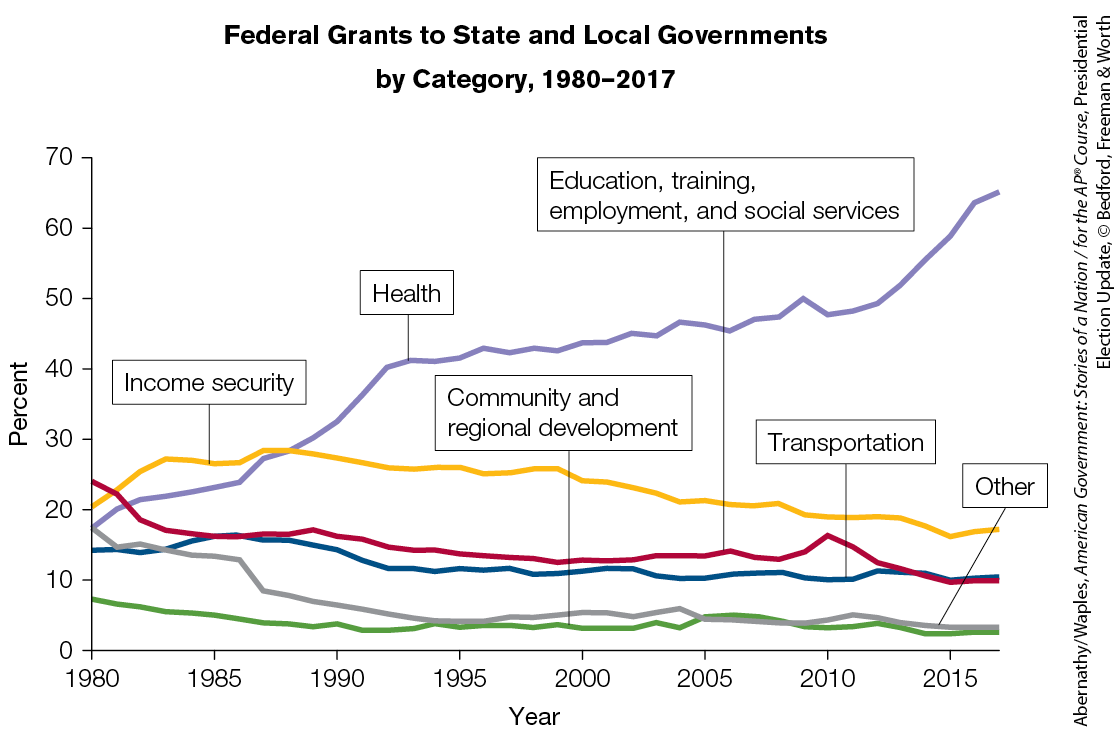What was the trend in the decisions of the Supreme Court under Chief Justice John Marshall?
The national government gained power in comparison to the states.
What is the first step to examining a political cartoon?
First, observe the cartoon's visual elements and any accompanying text, noting people, objects, and symbols. Then, reflect on the cartoon's purpose, context, and intended audience.
Describe federal systems.
Federal: Power is constitutionally shared between the national and state governments.
The map supports which of the following statements?
States have discretion in how to spend welfare funds they receive from the federal government.
How can we best describe the argument made in Federalist No. 10?
Factions are inevitable, but republican government can control them.
How can we best describe the impact of the Supreme Court’s decision in McCulloch v. Maryland?
The Court ruled that the necessary and proper clause allows the national government to create banks, strengthening national power.
Which of the following statements best describes the viewpoint in the cartoon?
Republicans claim to favor states’ rights, but they oppose the rights of states to pass policies with which Republicans disagree.
Describe unitary systems.
Unitary: The national government may grant certain powers to the states.
 How has the federal government been involved in state and local governmental affairs?
How has the federal government been involved in state and local governmental affairs?
The federal government has become MORE involved in state and local governmental affairs.
The idea of a [unitary] government involves in it, not only an authority over the individual citizens, but an indefinite supremacy over all persons and things, so far as they are objects of lawful government. . . . In [that] case, all local authorities are subordinate to the supreme; and may be controlled, directed, or abolished by it at pleasure. In [a federal system], the [regional] authorities form distinct and independent portions of the supremacy, no more subject, within their respective spheres, to the general authority, than the general authority is subject to them, within its own sphere.
—James Madison, Federalist No. 39
What constitutional concept is best reflected in the passage?
Dual federalism
Federal nutrition guidelines require public schools to serve healthy lunches to students and limit the amount of “junk food” available in vending machines.
A state seeking to challenge these nutrition rules should cite which case?
United States v. Lopez
The speech bubbles from each participant show symbol for dollar, yen, and Euro; together resembling the word "Yes." A view through the glass pane behind them shows placards that reads, “No”, “Non”, and “NAO”.
The cartoon from Europe also represents which theory of American democracy?
The protests shown in the cartoon are an example of...?
Elitism
Popular sovereignty
Tax protest groups have been organized throughout the United States. Some of these groups claim the tax system unfairly benefits the wealthy. Others oppose local property taxes. Some groups want a flat tax, in which everyone would pay the same percentage of income. These groups are an example of:
Civil society
What type of grants-in-aid is most likely to lead to the result shown in the map?
Block grants
He has the power of receiving ambassadors from, and a great influence on their appointments to foreign courts; as also to make treaties, leagues, and alliances with foreign states, assisted by the Senate, which when made becomes the supreme law of land. He is a constituent part of the legislative power, for every bill which shall pass the House of Representatives and Senate is to be presented to him for approbation. If he approves of it he is to sign it, if he disapproves he is to return it with objections, which in many cases will amount to a complete negative; and in this view he will have a great share in the power of making peace, coining money, etc., and all the various objects of legislation, expressed or implied in this Constitution.
—Antifederalist Paper 67
How can we summarize the argument made in Antifederalist Paper 67?
The Constitution creates an executive with too much power.
By holding that Congress may regulate activity that is neither interstate nor commerce under the Interstate Commerce Clause, the Court abandons any attempt to enforce the Constitution’s limits on federal power . . . —Justice Clarence Thomas, dissenting opinion, Gonzales v. Raich
How can we best describe the viewpoint conveyed in the quotation?
The system of federalism is threatened by the national government’s expansion of power under the commerce clause.

Which of the following statements best describes the viewpoint expressed in the political cartoon?
Supreme Court decisions do not resolve long-standing disagreements over social policy issues.
How do the separation of powers and federalism impact civil society?
There are multiple access points for civil society groups to influence policymaking.
Question 4 is based on the map of civil liberties throughout the world.
What conclusions about the US are supported by the map?
In comparison, the United States has a high level of civil liberties.
The idea of a [unitary] government involves in it, not only an authority over the individual citizens, but an indefinite supremacy over all persons and things, so far as they are objects of lawful government. . . . In [that] case, all local authorities are subordinate to the supreme; and may be controlled, directed, or abolished by it at pleasure. In [a federal system], the [regional] authorities form distinct and independent portions of the supremacy, no more subject, within their respective spheres, to the general authority, than the general authority is subject to them, within its own sphere.
—James Madison, Federalist No. 39
How can we best describe the author’s perspective and reasoning?
The powers that the Constitution would grant to the national government will not intrude upon the power of state governments.
In 1993, Congress enacted the Brady Handgun Violence Prevention Act, mandating that anyone seeking to buy a firearm must first undergo a federal background check. One provision in that act required state law enforcement officials to conduct those background checks. In Printz v. United States (1997), the Supreme Court declared that portion of the act to be unconstitutional, reasoning, “The Federal Government may not compel the States to enact or administer a federal regulatory program.”
What constitutional provision (Amendment) most supports the Court’s conclusion in the quoted language?
Tenth Amendment
Which of the following best describes the viewpoint in the cartoon?
The Constitution creates a republican form of government.
The Constitution is a living document that changes with the times.
The three branches of government have not been successful in protecting American democracy.
The Constitution provides strong protections against infringements of civil liberties.
The three branches of government have not been successful in protecting American democracy.
Why did Shays’s Rebellion cause concern about the effectiveness of the Articles of Confederation?
It demonstrated the financial insecurity of the national government (inability to collect taxes).
 How has federal funding shifted over time?
How has federal funding shifted over time?
The category receiving the largest federal funding has shifted over time from “Education, training, employment, and social services” in 1980 to “Health” in 2015.
He has the power of receiving ambassadors from, and a great influence on their appointments to foreign courts; as also to make treaties, leagues, and alliances with foreign states, assisted by the Senate, which when made becomes the supreme law of land. He is a constituent part of the legislative power, for every bill which shall pass the House of Representatives and Senate is to be presented to him for approbation. If he approves of it he is to sign it, if he disapproves he is to return it with objections, which in many cases will amount to a complete negative; and in this view he will have a great share in the power of making peace, coining money, etc., and all the various objects of legislation, expressed or implied in this Constitution.
—Antifederalist Paper 67
What constitutional provisions (Article, Section) best support the arguments made in Antifederalist Paper 67?
Article II, Section 1